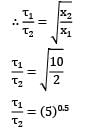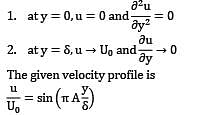Test: Boundary Layer Level - 1 - Mechanical Engineering MCQ
10 Questions MCQ Test - Test: Boundary Layer Level - 1
The transition Reynolds number for flow over a flat plate is 5 × 105. What is the distance from the leading edge at which transition will occur for flow of water with a free stream velocity of 1 m/s ? (For water, the kinematic viscosity is ν = 0.86 × 10−6 m2/s)
| 1 Crore+ students have signed up on EduRev. Have you? Download the App |
Under what condition does flow separation take place?
Friction drag is generally larger than the pressure drag in
A fluid is flowing over a flat plate. At a distance of 8 cm from the leading edge, the Reynolds number is found to be 25600. The thickness of the boundary layer at this point is
In a laminar boundary layer over a flat plate, what would be the ratio of wall shear stresses τ1 and τ2 at two sections which lie at distance x1 = 2 units and x2 = 10 units from the leading edge of the plate?
Consider the following statements pertaining to boundary layer on solid surfaces:
1. The boundary layer separation takes place if the pressure gradient is zero.

Boundary layer on a flat plate is laminar if the Reynolds number is less than 5 × 105.
Which of the above statements is/are correct?
The velocity distribution in a laminar boundary layer over a flat plate has been prescribed by the identity
![]()
The factor A will have an approximate value of
The velocity distribution in the laminar boundary layer is presumed to conform to the identity u /U0 = y / δ . The momentum thickness for this laminar boundary layer would be
Angle of diverging portion of the venturimeter is limited to 7°, because
1. Flow decelerates in the diverging portion and pressure increases in the downstream direction. Hence, the fluid experience an adverse pressure gradient, if the divergence angle is large.
2. Flow separation takes place due to adverse pressure gradient when divergence angle is large.
3. If the divergence angle is large, a negative pressure is created at the throat which obstructs the flow of fluid.
Which of the above reasons are correct?

























